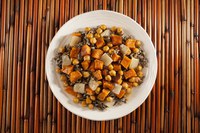Prairie Fare: Spring Toward Flavor During March, National Nutrition Month
(Click the image below to view a high-resolution image that can be downloaded)
By Julie Garden-Robinson, Food and Nutrition Specialist
NDSU Extension Service
Just a few days ago, I was hoping my vehicle wouldn’t slide off the road as I crept along an icy highway during one of North Dakota’s miniblizzards. However, on the day I wrote this article, I noticed areas of my lawn devoid of snow when I left my house.
Then someone ran by wearing shorts. I thought I might be hallucinating. No one was chasing this person, so I figured he was running to have fun.
The temperature wasn’t exactly “balmy” at 40 degrees but, after a long winter, any temperature above freezing is quite warm. Spring appears to have arrived at last.
We often feel rejuvenated in the spring. We eagerly put away our snowblowers and shovels. In fact, we are so energized by the sunlight and warm temperatures that we might clean our windows, closets, refrigerator and cupboards.
Many of us eagerly await planting flowers or vegetable gardens. Barbecue grills come out of storage, and people plan fishing adventures at nearby lakes.
After peeling off our thick, warm coats and fluffy sweaters, we might discover the aftermath of our winter hibernation. We might even launch ourselves into lifestyle changes, including improved nutrition and fitness habits.
March, which is National Nutrition Month, is a good time to consider some flavorful ways to improve our eating habits.
Unfortunately, people often think “nutritious” and “flavorful” food are two very different things. According to the National Academy of Nutrition and Dietetics, we can give our plate a “taste lift without forfeiting nutrition.”
Flavor is the major reason that people choose the foods that they do. We have 10,000 taste buds, so let’s use them this spring as we explore new flavors and cooking techniques. Joy Dubost, a registered dietitian and spokesperson for the academy, offered these tips to enhance flavor while maintaining nutrition.
- Intensify the flavors of meat, poultry and fish with high-heat cooking techniques such as pan-searing, grilling or broiling.
- Pep up your menus with peppers. Use red, green and yellow peppers of all varieties, including sweet, hot and dried. Or you can add a dash of hot pepper sauce.
- Try grilling or roasting veggies in a very hot (450 F) oven or grill for a sweet, smoky flavor. Brush or spray them lightly with oil so they don’t dry out. Sprinkle with herbs.
- Caramelize sliced onions to bring out their naturally sweet flavor by cooking them slowly over low heat in a small amount of oil. Use them to make a rich, dark sauce for meat or poultry.
- Simmer juices to make reduction sauces. Concentrate the flavors of meat, poultry and fish stocks. Reduce the juices by heating them, but don’t boil. Then use them as a flavorful glaze or gravy.
- For fuller flavors, incorporate more whole grains, such as brown rice or quinoa, or experiment with amaranth and wild rice.
- Add small amounts of ingredients with bold flavors such as pomegranate seeds, chipotle pepper or cilantro.
- Add a tangy taste with citrus juice or grated citrus peel such as lemon, lime or orange. Acidic ingredients help life and balance the flavor.
- Enhance sauces, soups and salads with a splash of flavored balsamic or rice vinegar.
- Give a flavor burst with good-quality condiments such as horseradish, flavored mustard, chutney or salsa.
Here’s a recipe that brings together some of the tips. We recently tried it in our test kitchen at NDSU, and it garnered rave reviews for its flavor combination. Try it as a tasty accompaniment to grilled pork, beef or chicken.
Smoked Paprika Wild Rice, Sweet Potatoes and Chickpeas
4 medium sweet potatoes, peeled and cut into about 1/2-inch cubes
1 1/2 large yellow onions, cut into about 1/2-inch pieces
1 (15-ounce) can chickpeas, drained and rinsed
1 c. prepared wild rice
2 tsp. smoked paprika
1 1/2 tsp. coriander powder
1 tsp. cumin powder
1/2 tsp. ground cinnamon
1/4 tsp. ground clove
1/4 tsp. ground nutmeg
1/4 tsp. cayenne pepper
1 tsp. salt
1/4 c. extra-virgin olive oil
Sour cream for garnish
Cilantro, chopped, for garnish
Cook the wild rice according to package directions. Drain and rinse 2 cups of chickpeas. Preheat oven to 375 F. In a large bowl, combine onion, sweet potato, chickpeas, wild rice, spices and olive oil. Mix well so that the spices and oil are combined evenly. Spread onto a baking sheet that is large enough to keep the mixture relatively shallow for roasting. Bake the vegetables for 45 minutes. Add or subtract time based on the tenderness of the sweet potatoes. While the mixture is cooking, be sure to rotate and mix the vegetables about every 15 minutes for even roasting. Serve hot with a dollop of sour cream (optional) and sprinkle with cilantro leaves.
Makes eight servings. Each serving has 220 calories, 9 grams (g) of fat, 6 g of protein, 32 g of carbohydrate, 3 g of fiber, 440 milligrams (mg) of sodium, and 38 micrograms of folate and 1.4 mg of iron.
(Julie Garden-Robinson, Ph.D., R.D., L.R.D., is a North Dakota State University Extension Service food and nutrition specialist and professor in the Department of Health, Nutrition and Exercise Sciences.)
NDSU Agriculture Communication – March 13, 2014
| Source: | Julie Garden-Robinson, (701) 231-7187, julie.garden-robinson@ndsu.edu |
|---|---|
| Editor: | Rich Mattern, (701) 231-6136, richard.mattern@ndsu.edu |


